Bring in the New Year with Marianne's Arctic Xpress. Spend Christmas or New Year in a remote Norwegian cabin. Chase auroras every night or join a day tour to see fjords, whales, eagles and an abundance of wildlife. Book Now | | |
SUNSET SKY SHOW: When the sun goes down tonight, step outside and look southwest. You'll find Venus and the crescent Moon beaming side by side through the deepening twilight. Try to catch them before the sky fades completely black. For reasons no scientist can explain, these two heavenly bodies are especially beautiful when surrounded by twilight blue. [sky map]
WATCH OUT FOR THE DA VINCI GLOW: If you go outside tonight to witness the meeting of Venus and the crescent Moon, pay special attention to the Moon. Cradled between the arms of the slender crescent is a display of light and shadow that puzzled sky watchers for thousands of years--until Leonardo Da Vinci figured it out. It's the "Da Vinci glow," also known as Earthshine:
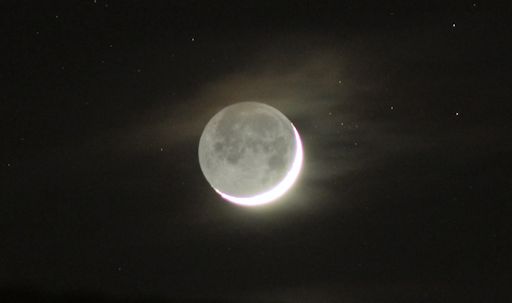
Richard Sears of Merced, California, took the picture last night. "I was getting ready for the Venus-Moon conjunction," he says. "The Earthshine was gorgeous."
For much of human history, people marveled at the faint image of the full Moon inside the arms of the crescent. Where did it come from? No one knew until the 16th century when Leonardo figured it out. He realized that dark lunar terrain was being illuminated by sunlight reflected from Earth.
Visualizing this in the 1500s required a wild kind of imagination. No one had ever been to the Moon and looked "up" at Earth. Most people didn't even know that Earth orbited the sun. Copernicus' sun-centered theory of the solar system wasn't published until 1543, twenty-four years after Leonardo died.
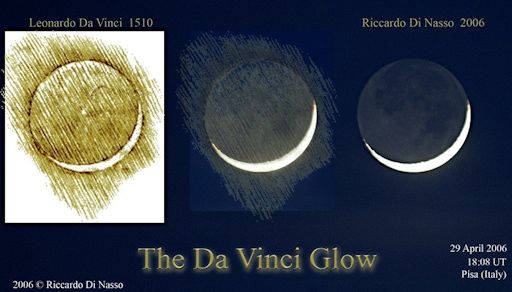
Above: Da Vinci's sketch of Earthshine in 1510 vs. Italian astronomer Riccardo Di Nasso's photo of Earthshine in 2006.
Wild imagination, however, was one thing Leonardo had in abundance. His notebooks are filled with sketches of flying machines, army tanks, scuba gear and other fantastic devices centuries ahead of their time.
In Leonardo's Codex Leicester, circa 1510, there is a page entitled "Of the Moon: No Solid Body is Lighter than Air." He states his belief that the "ghostly glow" is due to sunlight bouncing off Earth's oceans and, in turn, hitting the Moon. 500 years later, we know that Earth's clouds (not oceans) do most of the reflecting; but that is a quibble. Leonardo understood the basics well enough.
Go outside tonight and look to the sky. The Da Vinci Glow is waiting....
Realtime Space Weather Photo Gallery
REFLECTION RAINBOW: Spaceweather.com reader Chris Erikson was driving to work yesterday when he saw something strange. It was a rainy day on the Columbia River Gorge near the Oregon-Washington border, and a beautiful double rainbow arced across the sky. Suddenly, as passed the riverbank, another rainbow cut across the double 'bow. "I've never seen such a thing before," says Erikson, who snapped this picture through the front windshield:
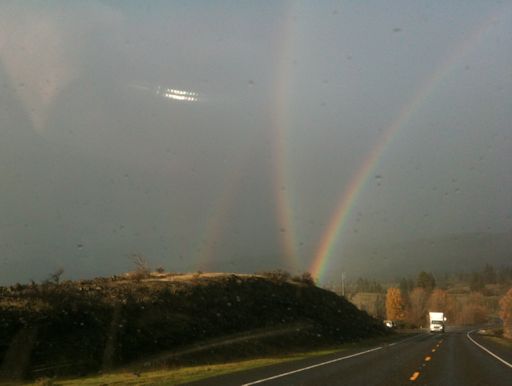
This is called a "reflection rainbow." To understand where it comes from, remember how normal rainbows form: Sunlight bounces in and out of falling raindrops. Those raindrops act like tiny prisms, spreading sunbeams into their constituent colors. Reflection rainbows form in the same way, except the source of light is not the sun; it's the reflection of the sun from a body of water.
"The sun must have been reflecting from the Columbia River, which was only 200 feet to my left," says Erikson. "Here's a map showing where I was."
Rainbows come in a variety of forms. The reflection rainbow Erikson photographed is just one of many you can see if you are alert for the unusual. Start looking here.
Realtime Space Weather Photo Gallery
BUY A TICKET TO THE EDGE OF SPACE: Christmas shopping for a young scientist? Consider this: For the holiday season only, we're reducing the cost of payload space on Earth to Sky Calculus balloons from $500 to only $299.95. Buy an edge of space gift certificate before Dec. 25th and your student can send an experiment, photo, or keepsake item to the stratosphere, completely supported by an Earth to Sky Calculus launch and recovery team.

This is not only a great Christmas gift, but also a good kickstarter for science fair projects. Experiments will be flown and returned along with video footage, GPS tracking, temperature, pressure, altimetry and radiation data.
To take advantage of the discounted rate, payment must be received before Dec. 25th. However, the flight can take place at any time in the next 12 months.
Conditions: No mammals. Plants and non-pathogenic microbes are allowed. Generally speaking, experiments should weigh less than ~300 grams and occupy a volume less than ~64 cubic inches. A Skype brainstorming session is included with each certificate. Dr. Tony Phillips and other members of the Earth to Sky team will chat with students to help them craft an experiment that will work in the harsh environment of the stratosphere.
More edge of space Christmas gifts may be found in the Earth to Sky Store.
Realtime Sprite Photo Gallery
Realtime Aurora Photo Gallery
Realtime Airglow Photo Gallery
Every night, a network of
NASA all-sky cameras scans the skies above the United States for meteoritic fireballs. Automated software maintained by NASA's Meteoroid Environment Office calculates their orbits, velocity, penetration depth in Earth's atmosphere and many other characteristics. Daily results are presented here on Spaceweather.com.
On Dec. 2, 2016, the network reported 39 fireballs.
(36 sporadics, 1 Quadrantid, 1 Geminid, 1 November omega Orionid)

In this diagram of the inner solar system, all of the fireball orbits intersect at a single point--Earth. The orbits are color-coded by velocity, from slow (red) to fast (blue). [Larger image] [movies]
Potentially Hazardous Asteroids (
PHAs) are space rocks larger than approximately 100m that can come closer to Earth than 0.05 AU. None of the known PHAs is on a collision course with our planet, although astronomers are finding
new ones all the time.
On December 2, 2016 there were potentially hazardous asteroids.
Notes: LD means "Lunar Distance." 1 LD = 384,401 km, the distance between Earth and the Moon. 1 LD also equals 0.00256 AU. MAG is the visual magnitude of the asteroid on the date of closest approach. | | Cosmic Rays in the Atmosphere |
Readers, thank you for your patience while we continue to develop this new section of Spaceweather.com. We've been working to streamline our data reduction, allowing us to post results from balloon flights much more rapidly, and we have developed a new data product, shown here:
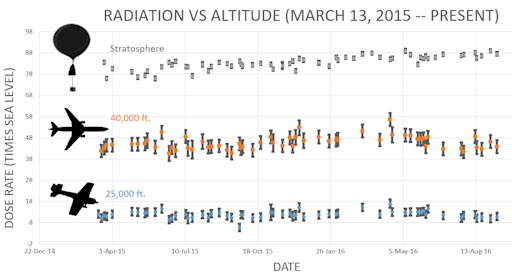
This plot displays radiation measurements not only in the stratosphere, but also at aviation altitudes. Dose rates are expessed as multiples of sea level. For instance, we see that boarding a plane that flies at 25,000 feet exposes passengers to dose rates ~10x higher than sea level. At 40,000 feet, the multiplier is closer to 50x. These measurements are made by our usual cosmic ray payload as it passes through aviation altitudes en route to the stratosphere over California.
What is this all about? Approximately once a week, Spaceweather.com and the students of Earth to Sky Calculus fly space weather balloons to the stratosphere over California. These balloons are equipped with radiation sensors that detect cosmic rays, a surprisingly "down to Earth" form of space weather. Cosmic rays can seed clouds, trigger lightning, and penetrate commercial airplanes. Furthermore, there are studies ( #1, #2, #3, #4) linking cosmic rays with cardiac arrhythmias and sudden cardiac death in the general population. Our latest measurements show that cosmic rays are intensifying, with an increase of more than 12% since 2015:
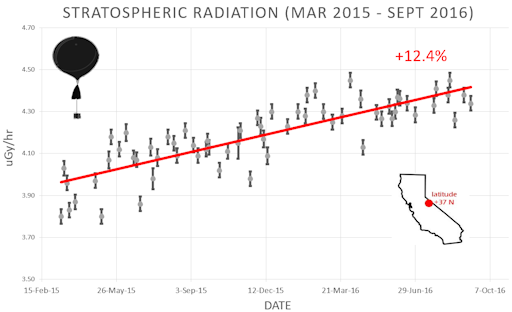
Why are cosmic rays intensifying? The main reason is the sun. Solar storm clouds such as coronal mass ejections (CMEs) sweep aside cosmic rays when they pass by Earth. During Solar Maximum, CMEs are abundant and cosmic rays are held at bay. Now, however, the solar cycle is swinging toward Solar Minimum, allowing cosmic rays to return. Another reason could be the weakening of Earth's magnetic field, which helps protect us from deep-space radiation.
The radiation sensors onboard our helium balloons detect X-rays and gamma-rays in the energy range 10 keV to 20 MeV. These energies span the range of medical X-ray machines and airport security scanners.
The data points in the graph above correspond to the peak of the Reneger-Pfotzer maximum, which lies about 67,000 feet above central California. When cosmic rays crash into Earth's atmosphere, they produce a spray of secondary particles that is most intense at the entrance to the stratosphere. Physicists Eric Reneger and Georg Pfotzer discovered the maximum using balloons in the 1930s and it is what we are measuring today.
| | The official U.S. government space weather bureau |
| | The first place to look for information about sundogs, pillars, rainbows and related phenomena. |
| | Researchers call it a "Hubble for the sun." SDO is the most advanced solar observatory ever. |
| | 3D views of the sun from NASA's Solar and Terrestrial Relations Observatory |
| | Realtime and archival images of the Sun from SOHO. |
| | from the NOAA Space Environment Center |
| | a proud supporter of science education and Spaceweather.com |
| | the underlying science of space weather |
 | Find homes for sale in Ocala, Orlando and Tampa with the #1 real estate company in Central Florida Local Realty Service |
| | These links help Spaceweather.com stay online. Thank you to our supporters! |

